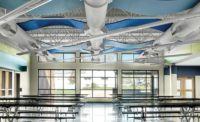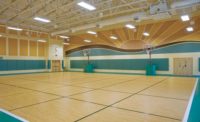FedEx Hub Selects Belgard for Largest Segmental Retaining Wall System




Completed this past summer, the sprawling new FedEx Ground Distribution Hub in Middletown, Connecticut, by many measures, qualifies as one the state's all-time largest construction projects, with the largest segmental retaining wall on the continent to date. To begin transforming the previous Aetna site into FedEx's airport-style nexus of distribution, massive volumes of earthworks needed to be reconfigured and contained by an intricate and durable Segmental Retaining Wall (SRW) system. Belgard's Vertica Retaining Wall System innovated by Anchor Wall Systems, along with Mirafi geogrid reinforcement were chosen to carry out the plans for these enormous wall structures.
Opened for operation in 2018, Terry Chappell, owner of the wall installation company, Earth Retention Systems, says this vast undertaking stands out as one of the largest and most complex Segmental Retaining Walls in North America. "When you think of how FedEx has been fueled by the rise of Amazon and other online retailers, it makes sense that their hub would need an incredible amount of space," he said.
As part of a nationwide expansion, FedEx's new campus project broke ground in Middletown in May of 2016 with an ambitious two-year time table. According to company officials, the growth is a response to greater consumer preferences for online shopping resulting in exponential increases in daily package shipments over the past decade.
Belgard was selected as the exclusive supplier of the retaining wall block and Mirafi geogrid materials. Belgard’s Cranston, RI, plant manufactured all of the Vertica Block for the segmental retaining wall project. "This selection was based on competitive price, proximity to the project, technical support, manufacturing capabilities, and the overall resources to supply such a large project on a tight time frame," explains Scott Vollmer, SRW market manager for Belgard's East region. Belgard's Vertica block is the ideal choice for large-scale retaining walls that require strength, durability, and a clean look in a near-vertical appearance.
The shipping giant's hub campus project involved moving an astounding 2.5 million cubic yards of earthwork that required six retaining wall structures, encompassing more than 11,000 linear feet of SRW to re-grade, stabilize and optimize the site. The project also called for more than 650,000 square-yards of geosynthetic reinforcement grid. Belgard’s business unit worked with the project’s retaining wall design engineers to calibrate specifications for installing the SRW units onto a Mirafi geosynthetic reinforcement base. The two products were used in tandem to create this magnificent engineering feat. The Mirafi base provided the stabilizing foundation for the vertically-rising Belgard SRW blocks. The completed retention wall configuration is comprised of more than 300,000 square feet of SRW block built to soaring heights of 60 feet, spanning two miles.
“Due to the size, complex installation and overall scope of the wall project, we knew right from the start it would have to be a collaborative effort by all to be a success story," remarked Chip George, general manager for Earth Retention Systems, LLC, installation contractor for the wall project. Along with his company, George notes that ''the general contractor, Manafort Brothers and the Belgard team all worked together to make that happen."
The design of the massive walls needed a proven system such as Vertica block with the Mirafi geogrid reinforcement," explained Vollmer. "Vertica's four-degree batter was another advantage of the system and allowed for optimal site layout." In practice, this ratio translates into a wall that steps in one inch for every four inches of height.
Terry Chappell agrees that the Vertica Block batter was a huge benefit for the project's design. "The batter is 4.1 degrees so it provides more room at the top of the wall due to the vertical degree of setback. The batter design allows you to gain as much space as possible at the top of the wall which is especially important with a 60 ft. wall." He further explains, "Owners and design engineers want to utilize as much area on every site for additional parking or a larger building envelope to get the biggest return on investment. On a 60 ft wall with a conventional 7- degree batter, the setback consumes 7' 6" of space at the top, whereas the Vertica' s 4-degree batter takes up only 4' 2". That alone provides 3' 4" ft. of extra useable space throughout the more than 11,000 linear ft. of walls constructed on this project."
The biggest challenge on this project was the tight schedule that had to be met. Manafort and Earth Retention Systems had to work very closely to hit all the milestones on the project. The companies changed their plan of attack numerous times to accommodate weather and to allow other contractors to perform their scope of work. "The schedule was very aggressive to begin with, said Chappell, with several days of rain and many other variables the team encountered. It made the schedule even more challenging as we installed about 3,500 sq. ft. of wall per day during good weather and our average daily production rate was between 2,200 and 2,500 sq. ft. per day." Despite the obstacles, Earth Retention Systems finished ahead of schedule. "I was especially very proud of my employees on site and in the office as well as our partner companies for stepping up and meeting the challenges of this project."
Upon completion, the 260-acre FedEx distribution site now houses a 525,000-square foot main building with several concourses branching off of it. The complex will serve as a key distribution hub for FedEx packages. The grounds also include a self-contained maintenance garage and salt storage shed to assure a steady logistical flow--swift package delivery is at the heart of every decision.
Belgard's Segmental Retaining Wall system, with innovations by Anchor Wall Systems, provided structural stability for ground retention as well as an aesthetically pleasing landscape design for the campus. The entire segmental retaining wall project, one of the most complex in North America, was opened for business in September 2018. "This major feat of engineering is one of the most successful SRW projects within the Belgard family," said Greg Piper, VP of sales, Belgard’s Northeast Region.
[Applications include terraced walls, site development, bridges, multi-family developments, DOT roadways, water channels, pools, extreme loading, and more. Textured units are available in straight or beveled face.]
Looking for a reprint of this article?
From high-res PDFs to custom plaques, order your copy today!








